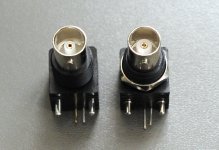Sorry for the handphone camera quality.
Correct me if I'm wrong, but isn't this a 50 ohm connector?
An externally hosted image should be here but it was not working when we last tested it.
An externally hosted image should be here but it was not working when we last tested it.
Correct me if I'm wrong, but isn't this a 50 ohm connector?
Is it an input or an output?
If its an input, you should be able to tell be measuring the resistance of the center pin and outer shell.
If its an output, you'll have to look at the buildout resistor in the circuit.
For most applications, it doesn't matter. In broadcast TV both are used interchangeably.
If its an input, you should be able to tell be measuring the resistance of the center pin and outer shell.
If its an output, you'll have to look at the buildout resistor in the circuit.
For most applications, it doesn't matter. In broadcast TV both are used interchangeably.
It's not about the cable, it's about the connectors.
The center pin of the 50 Ohm and the 75 Ohm connectors are of a different diameter.
So if you connect a small male to a large female you have a poor connection.
But if you connect a large male to a small female then you damage the female!
That all sounds so dirty.
For the short cable lengths and low frequencies that many of us work at, characteristic impedance is no big deal.
The center pin of the 50 Ohm and the 75 Ohm connectors are of a different diameter.
So if you connect a small male to a large female you have a poor connection.
But if you connect a large male to a small female then you damage the female!
That all sounds so dirty.
For the short cable lengths and low frequencies that many of us work at, characteristic impedance is no big deal.
Wow "DF96" I just learned something from you. I had always though that it was a mechanical size difference issue and we would warn the equipment installers about the damage that it would cause.
But Amphenol Connectors has a page:
Amphenol Connex- BNC Connector Series
Two distinct types of 75 Ω BNCs are available, and both mate with each other and with 50 Ω BNCs.
But Amphenol Connectors has a page:
Amphenol Connex- BNC Connector Series
Two distinct types of 75 Ω BNCs are available, and both mate with each other and with 50 Ω BNCs.
The difference in diameter...
is for the hole for the center conductor to go into. Fifty ohm cable center conductors are smaller than 75 ohm cable center conductors. Obviously the larger center conductor will not fit into the smaller pin.
BUT, I have done this. You can solder the pin on to the center conductor. Many years ago I attended an ADC seminar where they recommended soldering the pins on to the center conductor for digital applications. It seems that it reduces reflections at high frequencies.
is for the hole for the center conductor to go into. Fifty ohm cable center conductors are smaller than 75 ohm cable center conductors. Obviously the larger center conductor will not fit into the smaller pin.
BUT, I have done this. You can solder the pin on to the center conductor. Many years ago I attended an ADC seminar where they recommended soldering the pins on to the center conductor for digital applications. It seems that it reduces reflections at high frequencies.
Left connector is 75 ohm, one on the right 50 ohm. Rquired center pins appear to be same diameter. I used both and there was no problem with neither Neutrik or Vampire cable connectors match.
Some manufacturers, like Madrigal for instance, used 50 ohm connector in DACs and transports.
Some manufacturers, like Madrigal for instance, used 50 ohm connector in DACs and transports.
Attachments
- Status
- This old topic is closed. If you want to reopen this topic, contact a moderator using the "Report Post" button.
- Home
- Design & Build
- Parts
- Is this a 50 or 75 ohm BNC connector?
